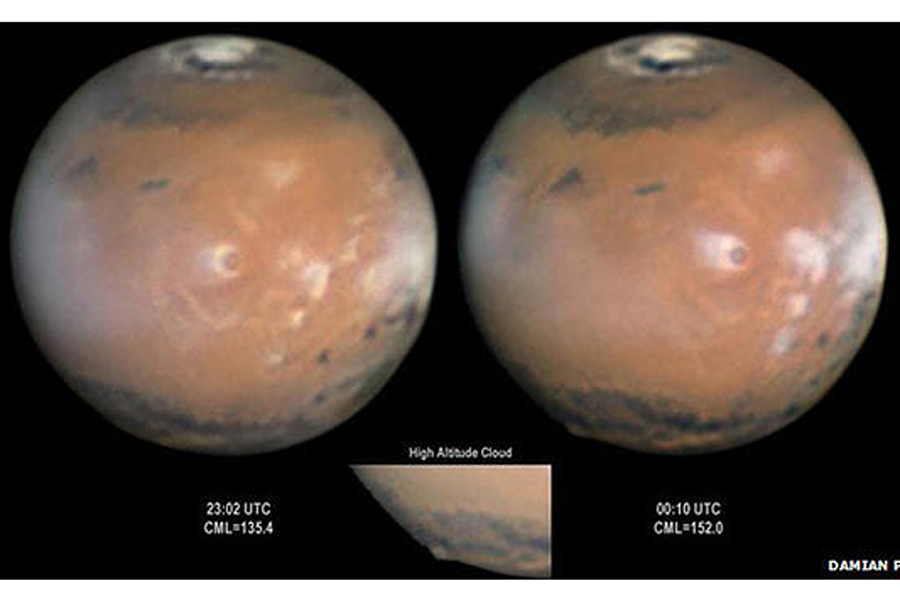Spotted by hobbyists, bizarre plumes on Mars baffle scientists
Loading...
Sen—Space scientists are baffled by mysterious plumes that have been spotted lifting from the surface of Mars as far as 250km (about 150 miles) into space.
Remarkably, despite the close scrutiny that Mars is being put under by a range of probes on the ground and in orbit, the discovery was made by amateur astronomers.
Damian Peach, famous for his meticulous images of the Universe, many taken with the support of Sen, was one amateur who caught the plume-like features developing over a region of the Red Planet in March and April 2012. Others were Wayne Jaeschke, Don Parker, and J. Phillips.
The plumes developed in less than ten hours and stayed on show for about ten days, changing their form from day to day. Their finding has led to them being included in the list of authors of a paper on the phenomenon that has been published in the science journal Nature.
To be fair to the orbiting space probes operated by NASA and ESA, they would not have been able to record the plumes from the orbits that they were in, due to geometry and illumination conditions.
However, another bit of space tech did record something similar. When the scientists looked back at the Hubble Space Telescope’s (HST) archive of Mars images, they found it had also caught similar plumes.
A set taken from May 17, 1997, showed an abnormally high plume rather like the one imaged in 2012. Other Hubble images taken between 1995 and 1999 and databases of amateur pictures from 2001 to 2014 showed only occasional high clouds up to 100 km (60 miles) altitude.
UK-based Peach told Sen: “The discovery was actually made quite accidentally by US observers Wayne Jaescke, Don Parker and myself during routine observations of Mars in the course of the 2012 opposition.
“Upon inspecting the data I had shot, it was very clear that something odd looking was poking out of the side of the martian disk. I had surmised that it could be a high altitude cloud as I knew the HST had seen them back in the late 1990s.
“This one however was more prominent and lasted for a long time. It was also seen more than once by several observers over a several week period.”
Lead author of the Nature paper Agustin Sanchez-Lavega, of the Universidad del País Vasco, Spain, said in a statement: “At about 250 km, the division between the atmosphere and outer space is very thin, so the reported plumes are extremely unexpected.”
Planetary scientists are now trying to find a cause for the peculiar plumes. They say that a future probe, ESA’s ExoMars Trace Gas Orbiter, might help find an answer following its launch in 2016.
Agustin added: “One idea we’ve discussed is that the features are caused by a reflective cloud of water-ice, carbon dioxide-ice or dust particles, but this would require exceptional deviations from standard atmospheric circulation models to explain cloud formations at such high altitudes.
“Another idea is that they are related to an auroral emission, and indeed auroras have been previously observed at these locations, linked to a known region on the surface where there is a large anomaly in the crustal magnetic field.”
Peach pointed out that the discovery showed that hobbyist astronomers can still make useful contributions to planetary science, thanks to their dedication and the photographic techniques they employ.
He told Sen: “I think these results (and some of those with Jupiter in recent years) speak volumes for the quality of work now being produced. There are still discoveries that can be made from amateur work, of which this paper is a prime example.”
Related Links:
Blog: Opportunity defies odds on 11th anniversary
Original story from Sen. © 2015 Sen TV Limited. All rights reserved. This material may not be published, broadcast, rewritten or redistributed. For more space news visit Sen.com and follow @sen on Twitter.







